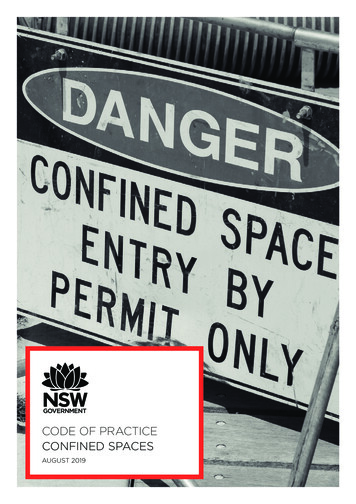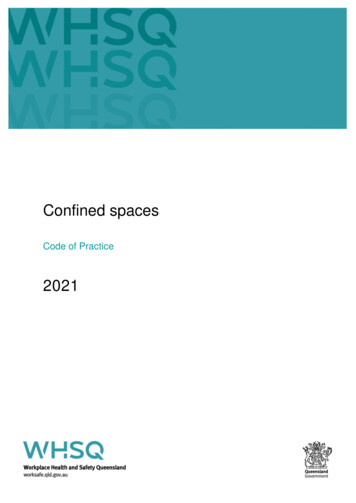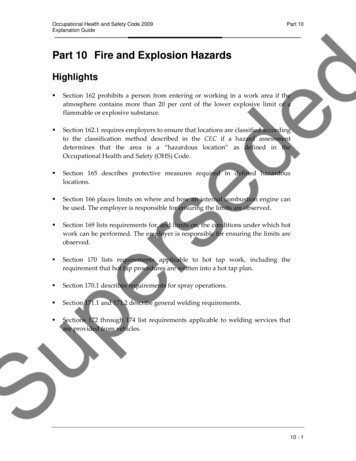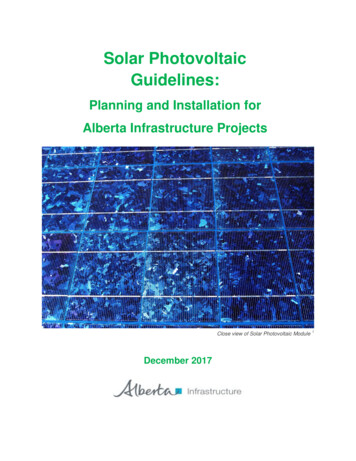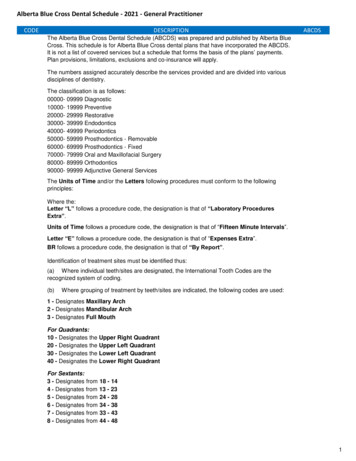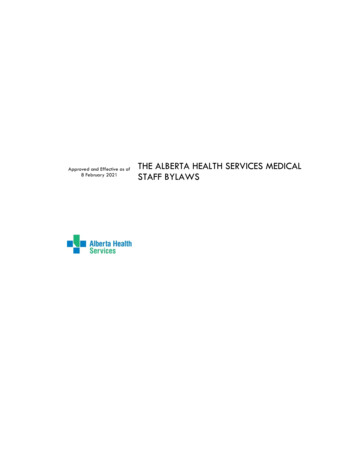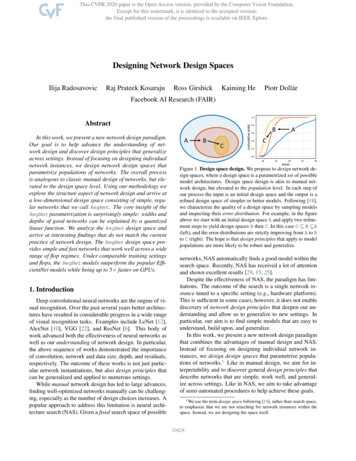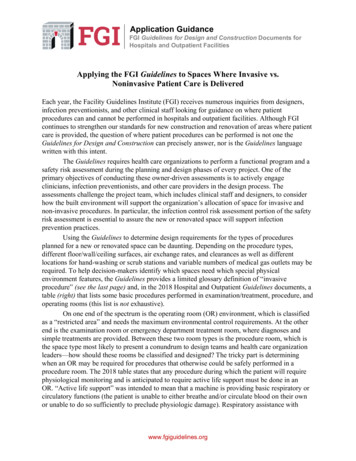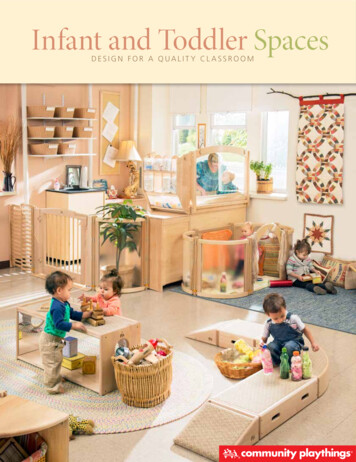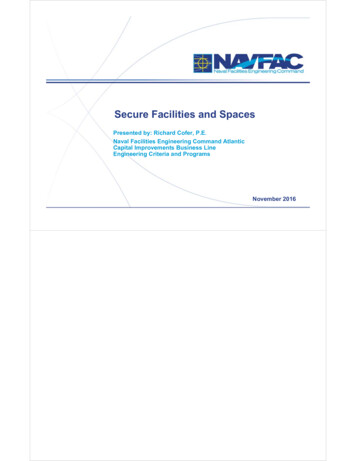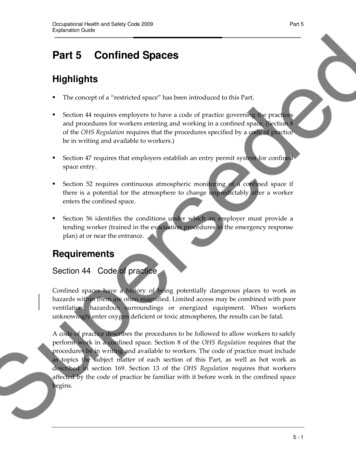
Transcription
Occupational Health and Safety Code 2009Explanation GuidePart 5Part 5Confined SpacesHighlights The concept of a “restricted space” has been introduced to this Part. Section 44 requires employers to have a code of practice governing the practicesand procedures for workers entering and working in a confined space. (Section 8of the OHS Regulation requires that the procedures specified by a code of practicebe in writing and available to workers.) Section 47 requires that employers establish an entry permit system for confinedspace entry. Section 52 requires continuous atmospheric monitoring of a confined space ifthere is a potential for the atmosphere to change unpredictably after a workerenters the confined space. Section 56 identifies the conditions under which an employer must provide atending worker (trained in the evacuation procedures in the emergency responseplan) at or near the entrance.RequirementsSection 44 Code of practiceConfined spaces have a history of being potentially dangerous places to work ashazards within them are often magnified. Limited access may be combined with poorventilation, hazardous surroundings or energized equipment. When workersunknowingly enter oxygen deficient or toxic atmospheres, the results can be fatal.A code of practice describes the procedures to be followed to allow workers to safelyperform work in a confined space. Section 8 of the OHS Regulation requires that theprocedures be in writing and available to workers. The code of practice must includeas topics the subject matter of each section of this Part, as well as hot work asdescribed in section 169. Section 13 of the OHS Regulation requires that workersaffected by the code of practice be familiar with it before work in the confined spacebegins.5-1
Occupational Health and Safety Code 2009Explanation GuidePart 5Workers should be consulted about the content of the code of practice as they oftenhave the best understanding of the hazards involved in the work. It may also help toask for the help of safety professionals such as industrial or occupational hygienistsor engineers, as some situations may be particularly complex.The code of practice must be maintained and periodically reviewed to ensure that itsprocedures are up‐to‐date and continue to reflect the work activities for which theywere originally written. The code of practice must also identify all existing andpotential confined space work locations at a work site so that workers can be madeaware of unexpected hazards and reminded that special safety requirements apply.Working in a confined space is potentially one of the most dangerous of allworkplace hazards. According to the New Zealand Department of Labour, workingin a confined space is 150 times more dangerous than doing the same job outside theconfined space.A worker is considered to have “entered” a confined space when the worker’sbreathing zone crosses the plane of the confined space access.Restricted and confined spacesThis edition of the OHS Code introduces the concept of a “restricted space”. Asdiscussed below, restricted spaces and confined space share certain commoncharacteristics. They differ however in key areas that may help employers andworkers to operate more safely and efficiently. Some employers and workers mayeventually come to think of restricted spaces as “non‐permitted confined spaces”.Restricted space explainedLike confined spaces, restricted spaces have a limited means of entry and exit. Entrypoints may not be designed for easy walk in. Other limitations include access byladders or by stairways that provide poor access because of steep slope, narrowwidth or extreme length. Physical obstructions such as bulkheads, collapsedmaterial, or machinery may impede exit. Limited means of entry and exit can makeescape or rescue difficult.A “restricted space” is an enclosed or partially enclosed space, not intended forcontinuous human occupancy that has a restricted, limited or impeded means ofentry or exit because of its construction. It can be thought of as a work area in whichthe only hazard is the difficulty of getting into or out of the space. All other hazardsare either non‐existent or have been eliminated or controlled as required by Part 2.Restricted spaces are therefore not subject to the permitting, atmosphere testing andtending worker requirements of a confined space. Employers and workers must be5-2
Occupational Health and Safety Code 2009Explanation GuidePart 5mindful that a restricted space can become a confined space if conditions or workpractices change. Employers who voluntarily apply relevant sections of ANSIZ117.1‐2003, Safety Requirements for Confined Spaces, might refer to restricted spaces as“non‐permitted confined spaces”.Examples of a restricted space include(a) an electrical or communication utility vault,(b) a building crawl space,(c) a trench with a temporary protective structure, and(d) a deep excavation requiring ladder or lift access.Despite being classified as a restricted space, the following requirements of Part 5Confined Spaces, continue to apply to workers entering a restricted space: a hazard assessment must be performed prior to entry — section 45; workers assigned duties related to the entry must be trained to recognizehazards and how to perform their duties in a safe and healthy manner —section 46; general safety requirements involving the use and availability of safety,personal protective, and emergency equipment, as well as a communicationsystem — section 48; prevention of unauthorized persons entering a restricted space — section 50; protection of workers from hazards created by traffic in the area of therestricted space — section 51; workers cannot enter or remain in a restricted space unless an effective rescuecan be carried out — section 55; a competent worker, designated by the employer, must be in communicationwith the worker(s) inside a restricted space — section 56; and a safe means of entry and exit must be available to all workers required towork in the restricted space — section 57.Confined space explainedAs defined in section 1 of the OHS Code, a confined space is an enclosed or partiallyenclosed space that is not designed or intended for continuous human occupancywith a restricted, limited, or impeded means of entry or exit because of itsconstruction and may become hazardous to a worker entering it because of(a) an atmosphere that is or may be injurious by reason of oxygen deficiency orenrichment, flammability, explosivity, or toxicity,(b) a condition or changing set of circumstances within the space that present apotential for injury or illness, or(c) the potential or inherent characteristics of an activity which can produce adverseor harmful consequences within the space.5-3
Occupational Health and Safety Code 2009Explanation GuidePart 5Confined spaces are not intended for continuous human occupancy. They are notsites of ongoing or regular work activity. They are usually entered only for suchpurposes as cleaning, inspection, maintenance, repair or construction. Figure 5.1shows a flowchart that helps to determine if the space is a confined space or arestricted space.Reasons for entering a confined spaceTypical reasons for entering a confined space include:(a) cleaning to remove sludge and other waste materials;(b) inspecting process equipment;(c) maintenance such as abrasive blasting and applying surface coatings;(d) tapping, coating, wrapping and testing underground sewage, hydrocarbon,steam and water piping systems;(e) installing, inspecting, repairing, and replacing, valves, piping, pumps, motors,etc. in below ground pits and vaults;(f) checking and reading meters, gauges, dials, charts and other measuringinstruments; and(g) rescue of workers who are injured or overcome while inside the confined space.In addition to other hazards, confined spaces may have limited means of entry andexit. This would not only make escape and rescue difficult, but could also restrictnatural ventilation.Types of confined spacesMost confined spaces are designed to hold substances such as liquids, gases, andloose materials, or to house equipment. Though they come in many sizes and shapes,most can be classified in one of two ways:(1) spaces that are open‐topped and have depth — examples include pits, wells,vats, hoppers, bins, degreasers, and kettles; and(2) spaces with narrow openings — examples include pipes, tunnels, silos, casings,and sewers.Confined spaces may have poor natural ventilation and contain, or have thepotential to contain, an atmosphere that is unsafe. Poor ventilation can be the resultof unpredictable or limited air movement, or natural air currents that could drawcontaminated air into the space. While unsafe atmospheres are most commonlyassociated with spaces that are fully enclosed, vats, pits and vessels that are open‐topped can also contain an unsafe atmosphere. In these cases, the unsafe atmosphereresults from the entry of a gas that is heavier than air, the release of gas resulting5-4
Occupational Health and Safety Code 2009Explanation GuidePart 5from wastes at the bottom of the space being disturbed, or the presence of a layer ofair above the space that prevents fresh air from moving into it.Confined spaces can become unsafe as a result of(1) atmospheric contamination by toxic substance ( a concentration of a substanceabove the regulated exposure levels or otherwise known as safe levels) orflammable vapours, or oxygen deficiency (less than 19.5 percent oxygen byvolume) or excess (more thatn 23.0 percent oxygen by volume);(2) physical hazards i.e. electrical, thermal, radiological, noise, engulfment, etc.(3) liquids, gases, or solids being introduced to the space during occupancy.Some confined spaces become unsafe as a result of the conditions or work that isdone inside them. Examples of conditions that can make a confined space unsafe are:(a) manholes in contaminated ground e.g. near a leaking underground gasolinestorage tank, into which poisonous or flammable gases can seep;(b) manholes, pits or trenches connected to sewers, in which there can be a build‐upof flammable and/or poisonous gases and/or insufficient oxygen in the air;(c) tanks or pits containing sludges and other residues which, if disturbed, maypartially fill the confined space with dangerous gases; and(d) confined spaces that contain rotting vegetation, rusting metal work, and similarnatural oxidation processes that create an oxygen‐deficient atmosphere.Some examples of confined spaces in which changing conditions or activities beingdone can make the space unsafe are:(a) some painting work and the application of certain adhesives, cleaners andliquids such as paint thinners. These can produce dangerous amounts of solventvapour, which can cause dizziness and impair judgment. Such solvents are oftenflammable so there is an accompanying risk of fire;(b) welding activities may generate toxic gases or vapours; and(c) the use of gasoline or diesel engines can lead to the build‐up of poisonous carbonmonoxide gas. There is also a risk of fire resulting from leaks; and(d) introduction of hot work.In some cases a confined space can become unsafe because of the inherentcharacteristics of activities that may occur external to the space. Examples include: the filling/emptying of an adjacent compartment/tank; weather changes, such as thunderstorms i.e. a drop in barometric pressure,lightning, etc.; heat of the day increasing vapourization and affecting personnel i.e. heatexhaustion; and pipelines entering the confined space may contain hazardous materials.Table 5.1 lists examples of confined spaces by industry.5-5
Occupational Health and Safety Code 2009Explanation GuideTable 5.1Part 5Examples of confined spaces by industryConstruction IndustrySewersUnprotected excavationsFood and SimilarProductsRetortsTubs and kettlesBasinsCold roomsOvensFlour binsAir scrubbersBatch cookersCaustic soda tanksClay hoppersConditionersContinuous cookersExtractorsHeated lard tanksHeated sugar binsHolding binsHydrogenatorsMetal binsMeal dryersMixersTallow tanksTextilesBleaching rangesJ-boxesKiersDie kettlesBale pressesDye becksSizing tanksSteam boilersPaper and PulpChip binsBarking drumsRag cookersAcid towersDigestersBeatersHydropulpersStock chestsAdhesive tanksBleach tanksChip silosFurnacesMachine chestsMix tanksResin tanksClay mix tanksPrinting and PublishingInk tanksSolvent tanksRubber ProductsSolvent tanksShreddersFurnacesOvensMixersPetroleum and ChemicalsReactorsStorage tanksDistillation columnsCooling towersDike areasFire water tanksPrecipitatorsScrubbersCrystallizersSpray dryersLeather ProductsDye vatsTanning tanksSludge pitsStone, Clay, Glass andConcrete ProductsKilnsAggregate binsCement silosCrushersDryersHoppersMillsSand binsPrimary MetalsBlast furnacesCupolasCoal binsCoke bunkersAnnealing furnacesSlag pitsWater treatment tanksSubmarine carsGas holdersSoaking pitsAcid pickling tanksPlating tanksFabricated MetalsPaint dip tanksDegreasersCaustic cleaning tanksDrying ovensShot blasting enclosuresEnclosed assembliesSludge tanksMachineryBoilersConveyorsDust collectorsTunnelsElectronic IndustryDegreasersGas cabinetsPlating/rinse tanksElectric, Gas andSanitary ServicesCable vaultsManholesMeter vaultsTransformer vaultsBar screen enclosuresChemical pitsIncineratorsPump stationsRegulatorsSludge pitsWet wellsValve pitsDigestersGrease trapsLift stationsSewage ejectorsStorm drainsBased on similar table in:Rekus JF. Complete Confined Spaces Handbook. National Safety Council, Lewis Publishers, AnnArbor; 19945-6
Occupational Health and Safety Code 2009Explanation GuidePart 5For more /WHS/WHS‐PUB cs001.pdfGuideline for Developing a Code of Practice for Confined Space f/confined.pdfSafe Working in a Confined lications/confined/2864 confined.pdfThey’re Not Desig
shows a flowchart that helps to determine if the space is a confined space or a restricted space. Reasons for entering a confined space Typical reasons for entering a confined space include: (a) cleaning to remove sludge and other waste materials; (b) inspecting process equipment; (c)
